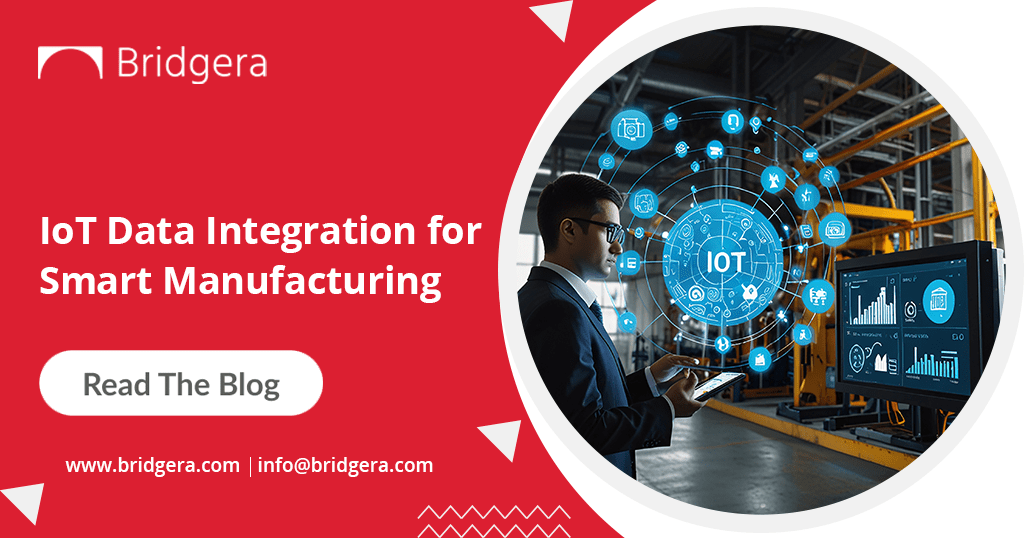IoT Data Integration: The Backbone of Smart Manufacturing
IoT data integration is the process of combining data from various IoT devices and systems into a cohesive platform. This enables businesses to gain valuable insights into their operations, improve efficiency, and drive innovation.
The Future of Manufacturing: Smart and Connected
Modern industries are adopting smart manufacturing practices, using IoT technology to enhance productivity and create intelligent operational environments. In these scenarios, IoT data integration becomes essential for transforming traditional factories into cutting-edge smart manufacturing hubs. Let’s explore how industries are applying IoT technology and the significance of a robust IoT data integration strategy.
IoT Data Integration in Action: Industrial Use Cases
IoT data integration has a broad spectrum of applications across various industries. Let’s explore some prominent examples:
Real-time Production Monitoring
One of the most significant applications of IoT in manufacturing is real-time production monitoring. By deploying sensors and IoT integrators, manufacturers can track a wide range of metrics, including:
- Production volume: Monitor output rates and identify bottlenecks.
- Machine efficiency: Evaluate equipment performance and optimize utilization.
- Operational anomalies: Detect and address issues promptly.
Key Benefits:
- Constant production oversight: Ensure operations run smoothly.
- Proactive identification and resolution of inefficiencies: Minimize downtime and optimize resource allocation.
- Maintenance of optimal production rates and quality: Deliver products on time and meet customer expectations.
Predictive Maintenance with IoT Data Integration
An effective IoT data integration strategy can transform maintenance protocols into a predictive approach. By analyzing IoT data, businesses can anticipate equipment failures before they occur, reducing downtime and maintenance costs.
Key Advantages:
- Remote equipment monitoring: Track machine performance and identify potential issues.
- Predicting potential failures: Utilize advanced analytics to anticipate equipment breakdowns.
- Proactive maintenance planning: Schedule maintenance activities to avoid disruptions.
Supply Chain Visibility
IoT data integration provides unparalleled visibility into supply chain operations. From tracking shipping progress to monitoring environmental conditions, IoT ensures precise tracking and informed decision-making.
Key Benefits:
- Real-time tracking of goods across global supply chains: Monitor shipments and identify potential delays.
- Mitigating risks through informed decision-making: Respond to challenges proactively.
- Enhanced logistical efficiency: Optimize transportation routes and reduce costs.
Energy Management and Efficiency Optimization
IoT data integration can streamline energy consumption, leading to cost savings and improved sustainability. Smart sensors and IoT dashboards can inform energy usage and guide optimization efforts.
Key Benefits:
- Monitoring and reporting on energy consumption: Identify areas of high energy consumption.
- Pinpointing opportunities for energy savings: Implement measures to reduce energy usage.
- Promoting sustainable manufacturing practices: Contribute to environmental conservation.
Customized Product Manufacturing
IoT integration enables manufacturers to increase customization in their production processes. By analyzing customer data, manufacturers can tailor production runs to meet specific demands.
Key Benefits:
- Analyzing customer data for tailored production runs: Identify customer preferences and preferences.
- Adjusting operations for bespoke product offerings: Deliver products that meet unique requirements.
- Serving niche markets with customized products: Expand market reach and increase customer satisfaction.
Enhanced Safety and Compliance
IoT data integration can bolster workplace safety and ensure regulatory compliance by continuously monitoring environmental conditions and ensuring all parameters are within established guidelines.
Key Benefits:
- Automated safety checks and compliance reporting: Streamline compliance processes.
- Receiving alerts for non-compliance risks: Address issues promptly.
- Prioritizing worker safety through monitored environments: Create a safer workplace.
IoT Data Integration Strategy: Key Components
A well-defined integration strategy is essential for successful IoT implementation. The following components should be included in your strategy:
- Data source identification: Determine the types of IoT devices and systems that will generate data.
- Data collection: Select appropriate methods for collecting data, such as APIs, messaging protocols, or data streaming platforms.
- Data preprocessing: Clean, normalize, and transform data to ensure quality and consistency.
- Data storage: Choose suitable storage solutions, such as databases, data warehouses, or cloud storage.
- Data integration: Develop integration pipelines to combine data from various sources.
- Data analysis: Select appropriate analytics tools and techniques to extract insights from the data.
- Data visualization: Create dashboards and reports to visualize data and communicate findings.
- Security and compliance: Implement measures to protect data security and comply with relevant regulations.
- Scalability: Ensure that the data integration solution can accommodate future growth and increasing data volumes.
- Maintenance and support: Establish processes for ongoing maintenance, updates, and support.
By carefully considering these components, you can develop an effective IoT data integration strategy that meets your specific needs and drives business value.
The Role of Bridgera in Your Smart Manufacturing Journey
Your Trusted Partner for IoT Data Integration
At Bridgera, we are committed to helping businesses utilize IoT data integration. Our comprehensive solutions enable you to:
- Collect and process data from a diverse range of IoT devices and systems, ensuring seamless data flow.
- Analyze data to extract valuable insights that drive informed decision-making and optimize operations.
- Visualize data through intuitive dashboards and reports, providing actionable insights at your fingertips.
- Integrate data with existing enterprise systems, streamlining workflows and enhancing operational efficiency.
By partnering with Bridgera, a leading IoT data integration company, you can:
- Utilize the capabilities of IoT to drive innovation and gain a competitive edge.
- Speed up your digital transformation with data-driven insights.
- Boost operational efficiency and reduce costs through optimized processes.
- Enhance customer satisfaction by delivering products and services that meet their evolving needs.
With our expertise in IoT data integration, Bridgera is your trusted partner in realizing the benefits of smart manufacturing. Contact us today to learn how we can help you improve your business.
About Bridgera: Bridgera effortlessly combines innovation and expertise to deliver cutting-edge solutions using connected intelligence. We engineer experiences that go beyond expectations, equipping our clients with the tools they need to excel in an increasingly interconnected world. Since our establishment in 2015, Bridgera, headquartered in Raleigh, NC, has specialized in crafting and managing tailored SaaS solutions for web, mobile, and IoT applications across North America.
About Author: Joydeep Misra is the Senior Vice President of Technology at Bridgera LLC, specializing in IoT and SaaS. He played a pivotal role in establishing and leading Bridgera’s IoT division, showcasing a dedication to innovation and excellence in the tech field. Additionally, he is an accomplished author and sought-after public speaker.
Search Our Blog
Most Recent
- Is Your Business Ready for AI? Find Out with the AI Readiness Assessment
- Bridgera Recognized as a Top AI, Logistics, and Software Development Company in 2025
- Predictive Maintenance in Manufacturing: How AI Is Transforming Uptime, Costs & Safety
- 5 Ways AI Can Address Logistics Challenges
- Industrial Revolution 4.0: IoT vs IIoT

